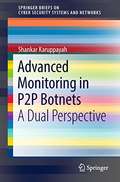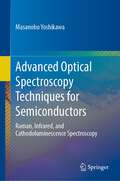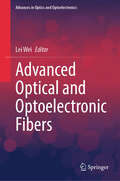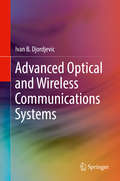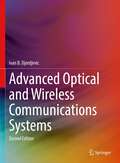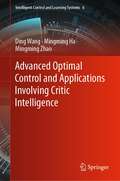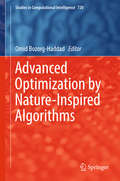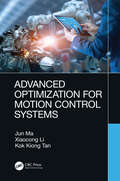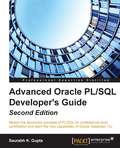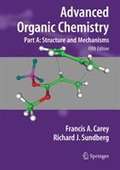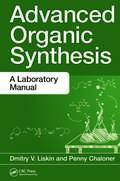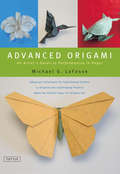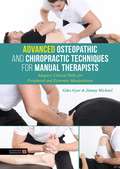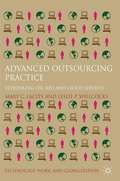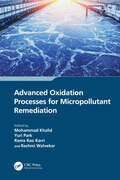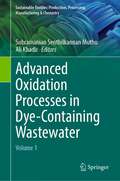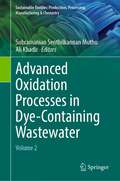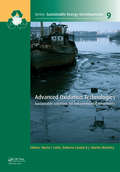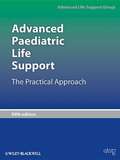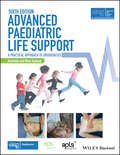- Table View
- List View
Advanced Optical Methods for Brain Imaging (Progress In Optical Science And Photonics #5)
by Gerd Keiser Fu-Jen Kao Ankur GogoiCompiles topics starting from the basics of neuroscience to the most recent advances in structural and functional brain imaging technologies.<P><P> Presents focused and comprehensive description of the physical principles, instrumentation, and the most recent brain imaging applications using optical methods.<P> Addresses the development of novel techniques like adaptive optics, click chemistry reactions, artificial neural networks, and the CLARITY method in the field of brain imaging.<P> This book highlights the rapidly developing field of advanced optical methods for structural and functional brain imaging. As is known, the brain is the most poorly understood organ of a living body. It is indeed the most complex structure in the known universe and, thus, mapping of the brain has become one of the most exciting frontlines of contemporary research. Starting from the fundamentals of the brain, neurons and synapses, this book presents a streamlined and focused coverage of the core principles, theoretical and experimental approaches, and state-of-the-art applications of most of the currently used imaging methods in brain research. It presents contributions from international leaders on different photonics-based brain imaging modalities and techniques. Included are comprehensive descriptions of many of the technology driven spectacular advances made over the past few years that have allowed novel insights of the structural and functional details of neurons.<P> The book is targeted at researchers, engineers and scientists who are working in the field of brain imaging, neuroscience and connectomics. Although this book is not intended to serve as a textbook, it will appeal to undergraduate students engaged in the specialization of brain imaging.
Advanced Optical Spectroscopy Techniques for Semiconductors: Raman, Infrared, and Cathodoluminescence Spectroscopy
by Masanobu YoshikawaThis book focuses on advanced optical spectroscopy techniques for the characterization of cutting-edge semiconductor materials. It covers a wide range of techniques such as Raman, infrared, photoluminescence, and cathodoluminescence (CL) spectroscopy, including an introduction to their physical fundamentals and best operating principles. Aimed at professionals working in the research and development of semiconductors and semiconductor materials, this book looks at a broad class of materials such as silicon and silicon dioxide, nano-diamond thin films, quantum dots, and gallium oxide. In addition to the spectroscopic techniques covered, this book features a chapter devoted to the use of a scanning electron transmission microscope as an excitation source for CL spectroscopy. Written by a practicing industry expert in the field, this book is an ideal source of reference and best-practices guide for physicists, as well as materials scientists and engineers involved in the area of spectroscopy of semiconductor materials. Further, this book introduces the cutting-edge spectroscopy such as optical photothermal IR and Raman spectroscopy or terahertz time-domain spectroscopy (THz-TDS) etc.
Advanced Optical and Optoelectronic Fibers (Advances in Optics and Optoelectronics)
by Lei WeiThis book highlights the recent scientific and technological innovations of various optical and optoelectronic fibers based on different functional structures and materials. Advanced optical and optoelectronic fibers locate at the intersection of many disciplines ranging from optical waveguides, optoelectronics, material engineering, micro/nanofabrication, and neural interfaces to wearable devices. The book covers the major developments on fiber materials, such as semiconductors, metals, polymers, and soft glasses, as well as novel in-fiber structures. Different functionalities are also summarized, including sensing, light guidance, lasing, and material engineering toward full system integration. The book is a valuable resource for researchers, engineers, and graduate students engaged in the study of optical and optoelectronic fibers.
Advanced Optical and Wireless Communications Systems
by Ivan B. DjordjevicThis textbook introduces the advanced topics of: (i) wireless communications, (ii) free-space optical (FSO) communications, (iii) indoor optical wireless (IR) communications, and (iv) fiber-optics communications and presents these different types of communication systems in a unified fashion for better practical use. Fundamental concepts, such as propagation principles, modulation formats, channel coding, diversity principles, MIMO signal processing, multicarrier modulation, equalization, adaptive modulation and coding, detection principles, and software defined transmission are first described and then followed up with a detailed look at each particular system. The book is self-contained and structured to provide straightforward guidance to readers looking to capture fundamentals and gain theoretical and practical knowledge about wireless communications, optical communications, and fiber-optics communications, all which can be readily applied in studies, research, and practical applications. The textbook is intended for an upper undergraduate or graduate level course in optical communication. It features problems, an appendix with all background material needed, and homework.
Advanced Optical and Wireless Communications Systems
by Ivan B. DjordjevicThe new edition of this popular textbook keeps its structure, introducing the advanced topics of: (i) wireless communications, (ii) free-space optical (FSO) communications, (iii) indoor optical wireless (IR) communications, and (iv) fiber-optics communications, but thoroughly updates the content for new technologies and practical applications. The author presents fundamental concepts, such as propagation principles, modulation formats, channel coding, diversity principles, MIMO signal processing, multicarrier modulation, equalization, adaptive modulation and coding, detection principles, and software defined transmission, first describing them and then following up with a detailed look at each particular system. The book is self-contained and structured to provide straightforward guidance to readers looking to capture fundamentals and gain theoretical and practical knowledge about wireless communications, free-space optical communications, and fiber-optics communications, all which can be readily applied in studies, research, and practical applications. The textbook is intended for an upper undergraduate or graduate level courses in fiber-optics communication, wireless communication, and free-space optical communication problems, an appendix with all background material needed, and homework problems. In the second edition, in addition to the existing chapters being updated and problems being inserted, one new chapter has been added, related to the physical-layer security thus covering both security and reliability issues. New material on 5G and 6G technologies has been added in corresponding chapters.
Advanced Optimal Control and Applications Involving Critic Intelligence (Intelligent Control and Learning Systems #6)
by Ding Wang Mingming Zhao Mingming HaThis book intends to report new optimal control results with critic intelligence for complex discrete-time systems, which covers the novel control theory, advanced control methods, and typical applications for wastewater treatment systems. Therein, combining with artificial intelligence techniques, such as neural networks and reinforcement learning, the novel intelligent critic control theory as well as a series of advanced optimal regulation and trajectory tracking strategies are established for discrete-time nonlinear systems, followed by application verifications to complex wastewater treatment processes. Consequently, developing such kind of critic intelligence approaches is of great significance for nonlinear optimization and wastewater recycling. The book is likely to be of interest to researchers and practitioners as well as graduate students in automation, computer science, and process industry who wish to learn core principles, methods, algorithms, and applications in the field of intelligent optimal control. It is beneficial to promote the development of intelligent optimal control approaches and the construction of high-level intelligent systems.
Advanced Optimization and Operations Research (Springer Optimization and Its Applications #153)
by Asoke Kumar Bhunia Laxminarayan Sahoo Ali Akbar ShaikhThis textbook provides students with fundamentals and advanced concepts in optimization and operations research. It gives an overview of the historical perspective of operations research and explains its principal characteristics, tools, and applications. The wide range of topics covered includes convex and concave functions, simplex methods, post optimality analysis of linear programming problems, constrained and unconstrained optimization, game theory, queueing theory, and related topics. The text also elaborates on project management, including the importance of critical path analysis, PERT and CPM techniques. This textbook is ideal for any discipline with one or more courses in optimization and operations research; it may also provide a solid reference for researchers and practitioners in operations research.
Advanced Optimization by Nature-Inspired Algorithms (Studies in Computational Intelligence #720)
by Omid Bozorg-HaddadThis book, compiles, presents, and explains the most important meta-heuristic and evolutionary optimization algorithms whose successful performance has been proven in different fields of engineering, and it includes application of these algorithms to important engineering optimization problems. In addition, this book guides readers to studies that have implemented these algorithms by providing a literature review on developments and applications of each algorithm. This book is intended for students, but can be used by researchers and professionals in the area of engineering optimization.
Advanced Optimization for Motion Control Systems
by Jun Ma Kok Kiong Tan Xiaocong LiPrecision motion control is strongly required in many fields, such as precision engineering, micromanufacturing, biotechnology, and nanotechnology. Although great achievements have been made in control engineering, it is still challenging to fulfill the desired performance for precision motion control systems. Substantial works have been presented to reveal an increasing trend to apply optimization approaches in precision engineering to obtain the control system parameters. In this book, we present a result of several years of work in the area of advanced optimization for motion control systems. The book is organized into two parts: Part I focuses on the model-based approaches, and Part II presents the data-based approaches. To illustrate the practical appeal of the proposed optimization techniques, theoretical results are verified with practical examples in each chapter. Industrial problems explored in the book are formulated systematically with necessary analysis of the control system synthesis. By virtue of the design and implementation nature, this book can be used as a reference for engineers, researchers, and students who want to utilize control theories to solve the practical control problems. As the methodologies have extensive applicability in many control engineering problems, the research results in the field of optimization can be applied to full-fledged industrial processes, filling in the gap between research and application to achieve a technology frontier increment.
Advanced Oracle PL/SQL Developer's Guide - Second Edition
by Saurabh K. GuptaMaster the advanced concepts of PL/SQL for professional-level certification and learn the new capabilities of Oracle Database 12c About This Book * Learn advanced application development features of Oracle Database 12c and prepare for the 1Z0-146 examination * Build robust and secure applications in Oracle PL/SQL using the best practices * Packed with feature demonstrations and illustrations that will help you learn and understand the enhanced capabilities of Oracle Database 12c Who This Book Is For This book is for Oracle developers responsible for database management. Readers are expected to have basic knowledge of Oracle Database and the fundamentals of PL/SQL programming. Certification aspirants can use this book to prepare for 1Z0-146 examination in order to be an Oracle Certified Professional in Advanced PL/SQL. What You Will Learn * Learn and understand the key SQL and PL/SQL features of Oracle Database 12c * Understand the new Multitenant architecture and Database In-Memory option of Oracle Database 12c * Know more about the advanced concepts of the Oracle PL/SQL language such as external procedures, securing data using Virtual Private Database (VPD), SecureFiles, and PL/SQL code tracing and profiling * Implement Virtual Private Databases to prevent unauthorized data access * Trace, analyze, profile, and debug PL/SQL code while developing database applications * Integrate the new application development features of Oracle Database 12c with the current concepts * Discover techniques to analyze and maintain PL/SQL code * Get acquainted with the best practices of writing PL/SQL code and develop secure applications In Detail Oracle Database is one of the most popular databases and allows users to make efficient use of their resources and to enhance service levels while reducing the IT costs incurred. Oracle Database is sometimes compared with Microsoft SQL Server, however, Oracle Database clearly supersedes SQL server in terms of high availability and addressing planned and unplanned downtime. Oracle PL/SQL provides a rich platform for application developers to code and build scalable database applications and introduces multiple new features and enhancements to improve development experience. Advanced Oracle PL/SQL Developer's Guide, Second Edition is a handy technical reference for seasoned professionals in the database development space. This book starts with a refresher of fundamental concepts of PL/SQL, such as anonymous block, subprograms, and exceptions, and prepares you for the upcoming advanced concepts. The next chapter introduces you to the new features of Oracle Database 12c, not limited to PL/SQL. In this chapter, you will understand some of the most talked about features such as Multitenant and Database In-Memory. Moving forward, each chapter introduces advanced concepts with the help of demonstrations, and provides you with the latest update from Oracle Database 12c context. This helps you to visualize the pre- and post-applications of a feature over the database releases. By the end of this book, you will have become an expert in PL/SQL programming and will be able to implement advanced concepts of PL/SQL for efficient management of Oracle Database. Style and approach The book follows the structure of the Oracle Certification examination but doesn't restrict itself to the exam objectives. Advanced concepts have been explained in an easy-to-understand style, supported with feature demonstrations and case illustrations.
Advanced Organic Chemistry
by David E. LewisWritten by a master teacher, Advanced Organic Chemistry presents a clear, concise, and complete overview of the subject that is ideal for both advanced undergraduate and graduate courses. In contrast with many other books, this volume is a true textbook, not a reference book.
Advanced Organic Chemistry
by Francis A. Carey Richard J. SundbergSince its original appearance in 1977, Advanced Organic Chemistry has maintained its place as the premier textbook in the field, offering broad coverage of the structure, reactivity and synthesis of organic compounds. As in the earlier editions, the text contains extensive references to both the primary and review literature and provides examples of data and reactions that illustrate and document the generalizations. While the text assumes completion of an introductory course in organic chemistry, it reviews the fundamental concepts for each topic that is discussed. <p><p> The two-part fifth edition has been substantially revised and reorganized for greater clarity. Among the changes: Updated material reflecting advances in the field since 2001’s Fourth Edition, especially in computational chemistry; A companion Web site provides digital models for study of structure, reaction and selectivity; Solutions to the exercises provided to instructors online. <p> The material in Part A is organized on the basis of fundamental structural topics such as structure, stereochemistry, conformation and aromaticity and basic mechanistic types, including nucleophilic substitution, addition reactions, carbonyl chemistry, aromatic substitution and free radical reactions. Together with Part B: Reaction and Synthesis, the two volumes are intended to provide the advanced undergraduate or beginning graduate student in chemistry with a sufficient foundation to comprehend and use the research literature in organic chemistry.
Advanced Organic Synthesis: A Laboratory Manual
by Penny Chaloner Dmitry V. LiskinLaboratory experience equips students with techniques that are necessary for professional practice. Advanced Organic Synthesis: A Laboratory Manual focuses on a mechanistic background of key reactions in organic chemistry, gives insight into well-established trends, and introduces new developments in the field.The book features experiments performe
Advanced Origami
by Michael G. LafosseAdvanced Origami provides unparalleled instruction in how to create master-class level paper folding projects. The origami designs are challenging-they require considerable folding experience-but the results are more art than craft-you'll create projects that you can display or give as gifts.Sophisticated origami or paper crafts fans will appreciate the ten unique origami designs included in the book--with complete how-to instructions and photographs.The book also features information on paper selection and preparation, advance techniques such as "wet folding," and making your own paper.
Advanced Origami
by Michael G. LafosseAdvanced Origami provides unparalleled instruction in how to create master-class level paper folding projects. The origami designs are challenging-they require considerable folding experience-but the results are more art than craft-you'll create projects that you can display or give as gifts.Sophisticated origami or paper crafts fans will appreciate the ten unique origami designs included in the book--with complete how-to instructions and photographs.The book also features information on paper selection and preparation, advance techniques such as "wet folding," and making your own paper.
Advanced Osteopathic and Chiropractic Techniques for Manual Therapists: Adaptive Clinical Skills for Peripheral and Extremity Manipulation
by Giles Gyer Jimmy MichaelDevelop your knowledge of chiropractic and osteopathy with this comprehensive guide to advanced skills and peripheral manipulation techniques. This practical handbook takes into account the latest research, highlighting the neurophysiological effects of these techniques, and providing clear, step-by-step guidance from experienced manual therapists.Covering key topics such as the effects of manipulation on organs, working in sports settings, and motion palpation misconceptions, the book demonstrates how to work with a range of joints with advice on diagnostics, contraindications and safety precautions. This is an expert collaboration between professions and can be used as the go-to clinical handbook for all manual therapists.
Advanced Outsourcing Practice
by Leslie P. Willcocks Mary C. LacityA rich database of over 2,200 outsourcing arrangements, studied across sectors and geographies, and over time, from inception, through contract signing, to outcomes. This book has unparalleled insight into the robust practices that have been proven effective time and again.
Advanced Oxidation Processes for Micropollutant Remediation
by Mohammad Khalid Rashmi Walvekar Rama Rao Karri Yuri ParkAdvanced Oxidation Processes for Micropollutant Remediation covers current state-of-the-art in advanced oxidation processes (AOP) for removal of micropollutants from industrial and pharmaceutical wastewater. It covers various AOP-based techniques like Fenton process, ozonation, hydrogen peroxide, ultraviolet radiation, electrochemical oxidation, ultrasonic irradiation, and other hybrid technologies. It focuses on aspects like impact of micropollutants on the ecosystems, different types of AOPs, their principles, applications, and challenges in implementing these techniques and their future perspectives. Features: Presents state-of-the-art in advanced oxidation processes (AOP) techniques along with hybrid technologies. Covers latest advances in technological know-how for remediation of wastewater soiled with micropollutants. Discusses pressing environmental pollution issues associated with AOPs needed for wastewater remediation. Presents future perspective as well as techno-economic analysis in implementing various AOPs. Reviews strategies to limit the micropollutants in water bodies. This book is aimed at graduate students and researchers in chemical and industrial engineering, environmental science, and wastewater treatment.
Advanced Oxidation Processes for Wastewater Treatment: An Innovative Approach (Wastewater Treatment and Research)
by Maulin P. Shah Sweta Parimita Bera Günay Yıldız TöreAdvanced Oxidation Processes for Wastewater Treatment: An Innovative Approach: This book highlights the importance of various innovative advanced oxidation technology to clean up the environment from pollution caused by human activities. It assesses the potential application of several existing bioremediation techniques and introduces new emerging technologies. This book is an updated vision of the existing advanced oxidation strategies with their limitations and challenges and their potential application to remove environmental pollutants. It also introduces the new trends and advances in environmental bioremediation technology with thorough discussion of recent developments in this field. This book highlights the importance of different innovative advanced oxidation process to deal with the ever-increasing number of environmental pollutants. Features: Illustrates the importance of various advance oxidation processes in effluent treatment plant Points out the reuse of the treated wastewater through emerging advance oxidation technologies for effluent treatment plant Highlights the recovery of resources from wastewater Pays attention to the occurrence of novel micro-pollutants Emphasizes the role of nanotechnology in bioremediation of pollutants Introduces new trends in environmental bioremediation
Advanced Oxidation Processes in Dye-Containing Wastewater: Volume 1 (Sustainable Textiles: Production, Processing, Manufacturing & Chemistry)
by Subramanian Senthilkannan Muthu Ali KhadirAmong various industries releasing wastewater into the environment, printing, dyeing and textile industries are of great importance as they frequently contain high amounts of colorful compounds having high chemical and biological oxygen demands. Health related effects of colorants are extensively reported; which necessitates the seriousness of dye removal from water and wastewater. The utilization of advanced oxidation processes (AOPs) in dye degradation has gained considerable attention recently due to the release of high energetic radicals as oxidants that are capable of removing dye compounds. This Volume 1 presents versatile applications of AOPs in dye removal. Accordingly, processes such as Ozone-based AOPs, UV irradiation, catalytic AOPs, etc are discussed with the aim of dye removal under different operational parameters. The role of different nanoparticles is also investigated. By presenting the fundamentals of AOPs as well as recent advances, this book is useful for environmental engineers and chemists who are concerned with wastewater pollution and treatment.
Advanced Oxidation Processes in Dye-Containing Wastewater: Volume 2 (Sustainable Textiles: Production, Processing, Manufacturing & Chemistry)
by Subramanian Senthilkannan Muthu Ali KhadirTextile industry wastewater contains toxic dyes as well as heavy metals and many other persistent organic compounds which are difficult to biodegrade using conventional biological methods. Advanced Oxidation Processes (AOPs) are one of the best alternatives for the effective degradation of such compounds. This Volume 2 starts with homogeneous and heterogeneous Fenton processes and reviews the application and variables that affect the process. It then discusses plasma technology- an emerging method in terms of its chemistry, treatment set-up, limitations, etc. The positive performance of carbon tetrachloride in process intensification of dye degradation is presented. The other chapters include topics such as sonoenzymatic treatment processes, electroflocculation versus textile wastewater, combination of photocatalysis and membrane Separation, and enhancement of anaerobic digestion and photodegradation through adsorption.
Advanced Oxidation Technologies: Sustainable Solutions for Environmental Treatments (Sustainable Energy Developments)
by Marta I. Litter Roberto J. Candal J. Martín MeichtryAdvanced Oxidation Technologies (AOTs) or Processes (AOPs) are relatively new and innovative technologies to remove harmful and toxic pollutants. The most important processes among them are those using light, such as UVC/H2O2, photo-Fenton and heterogeneous photocatalysis with TiO2. These technologies are also relatively low-cost and therefore usef
Advanced Packaging and Manufacturing Technology Based on Adhesion Engineering: Wafer-level Transfer Packaging And Fabrication Techniques Using Interface Energy Control Method (Springer Series in Advanced Manufacturing)
by Seonho SeokThis book introduces microelectromechanical systems (MEMS) packaging utilizing polymers or thin films – a new and unique packaging technology. It first investigates the relationship between applied load and opening displacement as a function of benzocyclobutene (BCB) cap size to find the debonding behavior, and then presents BCB cap deformation and stress development at different opening displacements as a function of BCB thickness, which is a criterion for BCB cap transfer failure.
Advanced Paediatric Life Support
by Martin Samuels Susan WieteskaThis international bestselling book on acute paediatric care is the coursebook for the Advanced Life Support Group's Advanced Paediatric Life Support (APLS). It uses their practical approach, a tried and tested method of treating children during the crucial first few hours of a life threatening condition. Advanced Paediatric Life Support is used in emergency and paediatric departments, by physicians, nurses and allied health professionals, and its clear layout and straightforward style make it a highly practical tool both for training and in the event of an emergency. The fifth edition includes major new features bringing it right up to date, including: The latest International Liaison Committee on Resuscitation (ILCOR) 2010 Guidelines A discussion on the importance of human factors A new and improved design including full colour photographs and diagrams With this book at hand, paediatric and emergency staff can be confident in having comprehensive and authoritative guidance on the first principles of recognising life threatening conditions through to all the procedures necessary to save a child's life.
Advanced Paediatric Life Support, Australia and New Zealand: A Practical Approach to Emergencies (Advanced Life Support Group)
by AlsgAdvanced Paediatric Life Support is the internationally renowned manual on emergency paediatric care, written to support the course run by the Advanced Life Support Group. This edition has been adapted specifically for use in Australia and New Zealand, with the latest procedures, medications and clinical best practice to match the guidelines of the Australia and New Zealand Resuscitation Councils. Using their structured approach, a tried and tested practical method of treating children during the crucial first few hours of a life threatening illness or injury, Advanced Paediatric Life Support is used by doctors, nurses and allied health professionals dealing with emergencies in children. Its clear layout and straightforward style make it a highly practical tool both for training and in the event of an emergency. The sixth edition includes major new features bringing it right up to date, including: Fully adapted for use in Australia and New Zealand, with updates to chapters on shock, the choking child, basic life support and cardiac arrest The latest International Liaison Committee on Resuscitation (ILCOR) 2015 Guidelines The latest consensus guidelines on paediatric trauma Enhanced discussions on the importance of human factors A new and improved design including full colour photographs and diagrams Free access to the Wiley E-Text With this book at hand, all those providing care during paediatric emergencies can be confident in having comprehensive and authoritative guidance on the recognition and management of life threatening conditions necessary to save a child's life.
